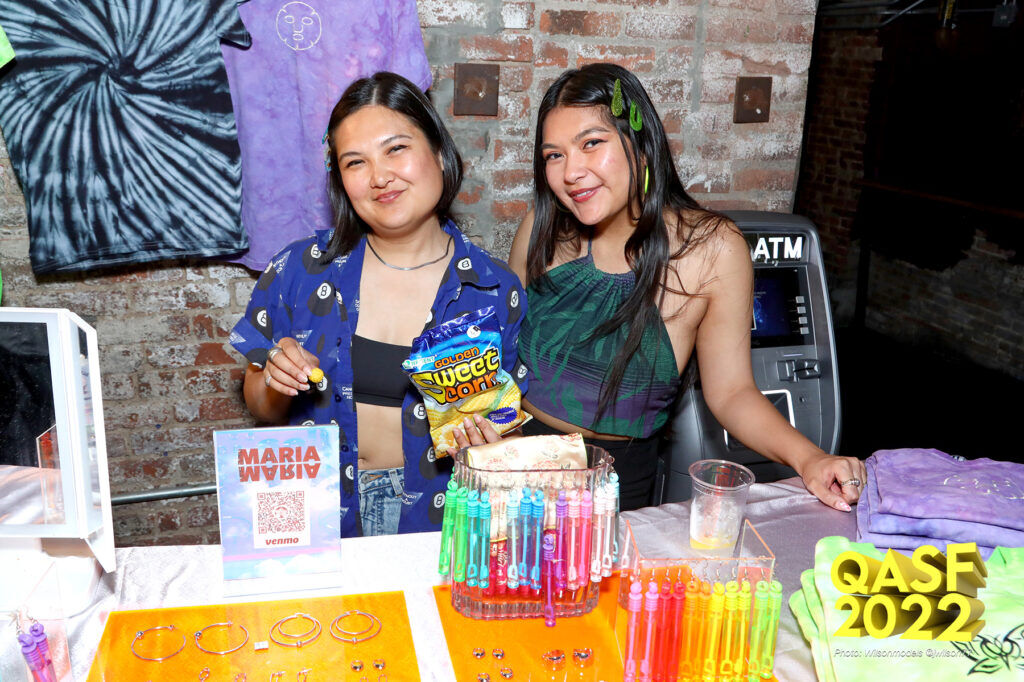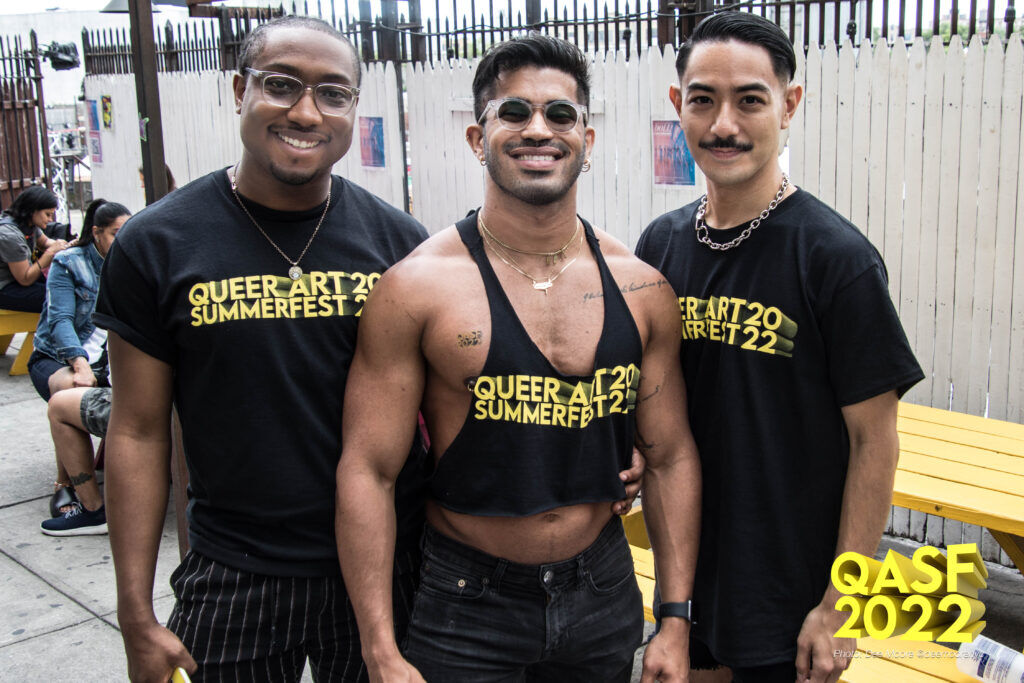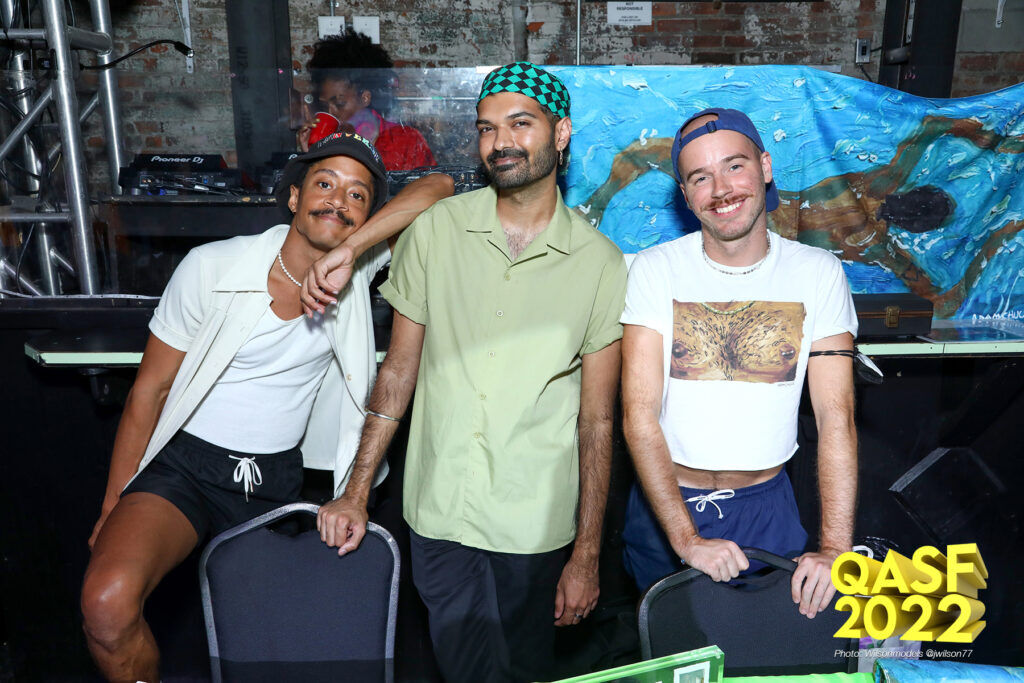Art and community go hand in hand. But queer artists Justin Reyes, Carlos Garcia, and Thomas Mars, the founders of Queer Art Fest, already know this.
The trio came together last year “to create accessible points of entry into the art world for queer artists & creators”. With dedicated efforts, these three have ushered in several events (like their upcoming Winterfest) in New York City where LGBTQ artists and creators can promote their artistic endeavors and build community.
But it’s not just us who love what Queer Art Fest is doing. They also have sponsors who see the benefit to uplifting this queer-owned nonprofit. Having worked with clothing retailer Nasty Pig, candle, fragrance, and intimate apparel company Boy Smells, 818 Tequila, sex toymaker Babeland, and NYC’s LGBT Center (known as The Center), more organizations are looking to collaborate with Queer Art Fest.
In a time where the queer art community has been profoundly impacted by the pandemic, Queer Art Fest became a model on how to reinvigorate it – by placing queer artists and queer community first.
INTO sat down with Queer Art Fest’s founders to dive about their origin story, learn how they keep up with the queer community’s art needs, and explore what’s in store for the future of Queer Art Fest.
View this post on Instagram
What is Queer Art Fest’s purpose and how did it come to be?
Carlos: Queer Art Fest was born out of the need to build and support the community of artists that were around us and to provide them with a space that was equitable, accessible, profitable, but ultimately amplify their voices. And in doing so, we’re committed to continuing to create these opportunities and connections to celebrate just that, the richness of our community.
Thomas: Our purpose is to support the economic advancement of queer artists and creators – it would be easy to say that we started this venture because of COVID – we know that queer artists were majorly financially impacted by the pandemic, but the need for community arts programs has and will always exist.
Justin: I think it’s important to note, as well, that we didn’t invent this concept. Marketplaces and community has such a long history in queer survival. We feel like there’s like this gap in the Brooklyn queer social scene. I think Carlos, Thomas, and I, in our existing experiences outside of queer art, we realized that we can leverage our connections and our skills and our commitment to our friends to do something for them, but ultimately for the community.

What events have you run so far and what events do you have on the horizon?
Justin: We have three Queer Art Fests under our belt. I also think it’s important to know that we really just started doing this last year. The first conversations that I remember having were like in May of last year or so. Then our first Summerfest was in July of 2021 and then we had Winterfest in December, and then we just recently had our last Summerfest.
Thomas: We are excited about evolving and expanding our horizons to include a wider range of queer art practices in our lineup of programming.
Justin: Within our wish list of events and activities is really thinking about how to support specific artists, whether that’s a product launch or a category specific mini fest. I think we’re really starting to think about what the universe of Queer Art Fest can look like, but really wanting to make sure that we tie that back to the needs of the community.
Thomas: The queer art umbrella is very broad.
Carlos: Sometimes we can get super ambitious, but again, to Justin’s point, we’ve been around for a year, so we’re just trying to scale appropriately so that we can always support the artists. And I think that going into programming that’s more category specific is probably the best way that we’re going to do that in between our tentpole events.
How are you keeping tabs on what the queer art community needs?
Justin: I think we’re really lucky in that our community, a lot of them are close to the artists that we work with, have featured at our events, and they have opinions about what they want to see. They always come up to us at the event and say, “You should do this more often or you should do XYZ”. We’re lucky that people naturally give us the feedback around what they want, then it becomes a matter of what is achievable for the three of us.
Carlos: It is a lot of word of mouth and I think it goes back to the “golden rule”, treat people how you want to be treated. I think we create this really incredible experience for the vendors and they tell their friends and that’s how we’ve been able to bring in new vendors and make sure that we’re always creating space for new people in our community. We’re also going through Instagram profiles, we’re showing up to galleries, and things like that and really trying to build on the community.

Is there a dream sponsor or affiliate that you would like to work with?
Carlos: I don’t know if there’s a dream collaboration but in the process of finding affiliates and people to work with, I always want to continue to keep in mind that they want to honor the artists and the work. Their stamp is to really help amplify voices, but not take over the space and become overly branded. It’s not about them, so much as it is about the community of people that we’re fostering. So I think as we scale and we grow, hopefully those partnerships do too, and that lends itself to doing just that.
Justin: Yeah, it’s a fine balance, right, because we, on one hand, have a very material need for financial sponsorship, but on the flip side of that, we want to make sure that, one, we’re aligned values wise with whoever we partner with, and two, we want to make sure that the focus is on the artists and the focus is on what the community needs and wants.
Thomas: We are blown away by the generosity of brands that have supported our organization in our infancy, whether it’s with product donations or sponsorships. We’re excited about further developing meaningful collaborations with brands and organizations that take action-based steps to support our community. For example, Partnering with Apicha Community Health Center was wonderful – they brought their pop-up clinics to last December’s Winterfest and provided our community with easy access to COVID and Flu vaccines, HIV/STI testing and SNAP enrollment. But a dream brand collaboration for the future would include funding for an artist grant program.
Carlos: Also, we have a great group of volunteers who show up every time to support us as well, and I just think that we all really love it. That’s why it seems so easy. It feels effortless because it’s truly a group of friends helping out their other friends. So it’s really organic and grassroots.
Justin: And we’re really fortunate that these brands have kindly donated their products to us. There was no precedent for what we were doing. The three of us are not influencer girls and, yet, we are supported by this network of companies as well as volunteers.
How can folks learn more about Queer Art Fest and support it?
Justin: I’m going to say it again. We love our donors. We need more of them. And let me just be real, donations matter. I think for such a small organization like ours, they go such a long way. $5 here and there goes such a long way for us to do what we do.
Thomas: We are a newly established nonprofit, so our current major need is funding. You can make a tax deductible donation by visiting our website.
Justin: But for people to get involved, we’d love to have more volunteers in our group.
Carlos: Yeah, 1000%. I think showing up is just the best way to get involved with us. We’re a DM away. We’re super accessible in that way. If you’re ever interested or if you just want to help spread the word, just show up to one of our events. And obviously, donations are valuable. That has such an impact on what we do and just helping all the artists that we work with.

What do you hope for the future of Queer Art Fest?
Carlos: We talk about the future often. And I think one of the things we agree on is really becoming incubators in the community. Having a permanent space for people to create, for people to show, for people to sell, and develop their work.
Thomas: Opening a gallery with an artist-in-residence program. guest curators, pop-up events, artist grants, etc.
Justin: Yeah, I think a physical space in whatever shape it takes would change so much for us. Because, like Carlos said, that could be a space for people to drop in and use during office hours and use it to do their admin work or to shoot content for their Instagram. We’re really thinking about the full ecosystem of what it takes to be a thriving artist in this current cultural and economic context that we’re currently living in.

Learn more about Queer Art Fest here and check out their next events below:
*Saturday, November 5, 2022: Warren Giddarie Photography Calendar Launch & Exhibition / The Brick Aux Gallery, 628 Metropolitan Avenue / 5-9pm // FREE
*Saturday, December 10, 2022: 2nd Annual Queer Art Winterfest / 3 Dollar Bill, 260 Meserole St / 2-8pm // FREE
Queer Art Fest Founders:
Justin Reyes (He/Him) is a Queer Filipino marketing professional based in Brooklyn. He is currently the Brand Specialist at APPARATUS, a Queer-founded design studio in Manhattan.
Thomas Mars (He/Him) is a Brooklyn based artist and event producer. Originally from Melbourne, Australia, he has spent the past decade in NYC and has worked with a wide variety of York based community programs and nonprofits throughout his career.
Carlos Garcia (He/Him) is a Queer Latinx DJ, Event Producer, and Candle Maker based in Brooklyn, NY.
Don't forget to share:
Help make sure LGBTQ+ stories are being told...
We can't rely on mainstream media to tell our stories. That's why we don't lock our articles behind a paywall. Will you support our mission with a contribution today?
Cancel anytime · Proudly LGBTQ+ owned and operated
Read More in Entertainment
The Latest on INTO
Subscribe to get a twice-weekly dose of queer news, updates, and insights from the INTO team.
in Your Inbox













